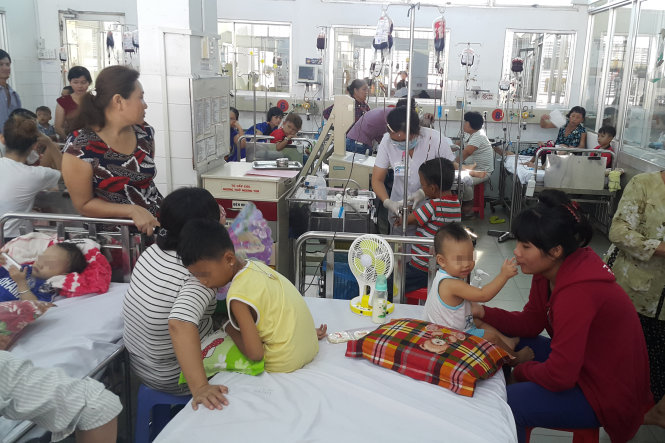Experts warn of insecticide-resistant mosquitoes in Viet Nam
As Viet Nam continues to report rising numbers of dengue fever infections, experts warn that virus-carrying mosquitoes in the country may have developed a resistance to insecticides.
 |
| Dengue-infected children are cared for by parents at Children’s Hospital 1 in Ho Chi Minh City. Tuoi Tre |
Despite being months away from traditional dengue fever seasons, Ha Noi is already reporting between 1,000 and 2,000 new infections on a weekly basis.
In total, the number of patients diagnosed with the mosquito-borne disease in the Vietnamese capital this year is 10 times higher than the same period of 2016.
The trend is countrywide. So far, 26 out of 63 provinces and cities in Viet Nam have reported a higher number of dengue patients year-on-year.
Insecticide resistance
A number of families in Ha Noi have reported seeing the re-population of mosquitoes in their neighborhood just a few days after insecticides were sprayed as a public effort to combat the dengue fever.
This observation has given rise to concerns that the local mosquito population might have developed a resistance to certain chemicals.
Tran Nhu Duong, director of the National Institute of Hygiene and Epidemiology, said the two main chemicals used in public campaigns to kill off mosquitoes in Ha Noi are still largely effective against the insect.
However, in parts of Thanh Tri and Hai Ba Trung Districts, there have been signs of resistance development in the mosquitoes, Duong noted.
Duong suggested using different chemicals in these areas for better results.
According to Duong, spraying insecticides should only be carried out at the peak of the outbreak to avoid the insects developing resistance to the chemicals.
Duong also advised families against applying insecticides at their own home unless the same is done at neighboring houses.
A more effective measure to prevent mosquitoes from populating is to clear stagnant water, a common breeding ground for mosquitoes, around homes, he added.
 |
| Dengue-infected children are cared for by parents at Children’s Hospital 1 in Ho Chi Minh City. Photo: Tuoi Tre |
Record infections
Seventeen dengue fever-related deaths have occurred across Viet Nam so far this year, according to Nguyen Duc Khoa, an outbreak control official at the Department of Preventive Medicine under Viet Nam’s Ministry of Health.
The total number of detected infections nationwide has reached almost 60,000, over 50,000 of which included hospitalisation while the rest opted for home treatment, Khoa said.
Despite reporting a tenfold increase in dengue fever patients this year compared to 2016, Hanoi was not ranked among provinces and cities with the highest number of infections per 100,000 citizens.
Topping this list are Da Nang, Binh Duong, Ho Chi Minh City, Ba Ria – Vung Tau, Binh Phuoc, Soc Trang, Phu Yen, Quang Nam and Dong Nai, Khoa said.
Viet Nam saw an unusually early outbreak of dengue fever this year, with hiking infections reported as early as early July although the yearly epidemic typically begins in September.
Dengue fever is a mosquito-borne tropical disease caused by the dengue virus, with symptoms that include fever, headache, vomiting, muscle and joint pains, and a characteristic skin rash.
Viet Nam is amongst the countries most affected by the illness due to its favorable environment for the growth of yellow fever mosquitoes, or Aedes aegypti, a vector for spreading the dengue virus.
(Source: Tuoitrenews)